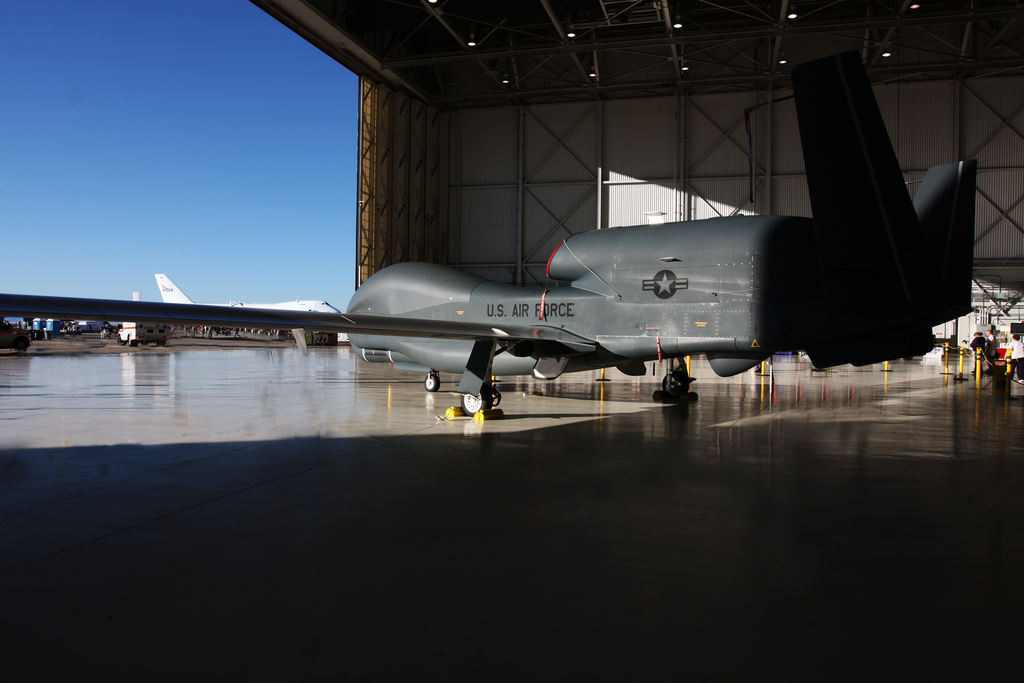
Attack of the Drones: The Ethics of Modern Warfare
In the good old days, going to war meant travelling to where the war was. Pack your bags, don’t forget your toothbrush, say goodbye. For about five hundred US Air Force pilots, that inconvenience no longer exists. Their war is sedentary, carried out in rooms at Offutt Air Force Base on the line between Nebraska and Iowa. But while their bodies may be at rest, their minds are elsewhere – drifting over the line between Afghanistan and Pakistan at 200mph, controlling Unmanned Aerial Vehicles, know to the rest of us as drones, via joysticks and a jumble of monitors. The occasional click every month will, after taking three seconds to transmit by satellite, propel a Hellfire missile from one of these pilotless planes and terminate the lives of people on the other side of the world, guilty or innocent. Normally, it’s a mixture of both.
The theatre of war has changed, and drones – from 20 meter airborne killing machines to hand-sized gadgets able to fly through windows – are taking centre stage. 9/11 gave America a new set of enemies, groups like al-Qaeda which are not defined by geography and have no headquarters. Now, after two disastrous wars partially aimed at ridding the world of Islamic terrorism, drones have come into their own. “It’s the least bad option” says a depressing report by the New American Foundation on their use. Many believe this long-distance killing is the biggest military innovation for centuries, giving rise to what has been dubbed the ‘Push-Button War’.
It’s too easy to think that Barack Obama, with a Nobel Peace Prize under his belt, is ‘softer’ than his predecessor – but in his time so far in office he has pushed the US drone programme to more ruthless heights than ever before, massively increasing the number of UAV air strikes. Drones operated by USAF from Offutt are in the public sphere and subject to scrutiny; the same cannot be said about those drones operated from the heart of Langley, Virginia, the base of the CIA. From here and another airbase in Nevada, controllers regularly assassinate targets in countries such as Yemen and Pakistan where the US has no official combat presence. The pilots are civilians, many of them contractors from Xe Services (formerly known as Blackwater Worldwide, the company notorious for the brutal mercenaries it hired out to the US government during the Iraq war).
The CIA drone programme has had its successes, killing high profile targets such as Baitullah Mehsud, a Taliban leader who was responsible for the murder of Benazir Bhutto, and decimating the leadership of al-Qaeda. But it is an imprecise science, where faulty intelligence is guaranteed to cause the deaths of innocent people. Estimates vary massively (and inexplicably) from about 10% civilian deaths to 90% – take the most likely figure of 30% and it’s still much too high. Mehsud was only killed after 16 attempts, one of which blew up a funeral.
Pakistan’s government officially objects to drone strikes, but its intelligence service, the ISI, is believed to be a major source for intelligence on targets. Pakistani officials were invited to watch live video of Mehsud’s death, which blew off everything apart from his torso and killed his young wife. It’s likely that the ISI feeds intelligence to the US on its own targets, those who are not necessarily related to the War on Terror. “Often, they say an enemy of theirs is al-Quaeda because they just want to get rid of somebody,” says a former CIA officer.
Setting aside the loss of innocent life, drones are fodder for the global propaganda machines maintained by Jihadist terrorists: pictures and videos of victorious insurgents next to shot down drones abound, and according to a recent poll, the vast majority of Pakistanis resent the strikes. The programme is much cheaper and more effective than using conventional air strikes, to the extent that this year’s USAF intake consists of more drone pilots than actual pilots. But riskless killing from thousands of miles away is, unsurprisingly, seen as cowardly and it’s a wet dream for al-Quaeda’s PR division. To add to this, there are rumors about USAF recruiters going talent-hunting in games arcades; US military expert P.W Singer uncovered one case where a geeky 19-year old who had dropped out of high school was able to become a drone instructor in two years because of his prowess on an Xbox.
Neither has the CIA program gone unnoticed by lawyers and civil rights groups in America. There is no accountability or transparency, meaning that the CIA can basically choose to kill whoever it wants. The hit list includes an American citizen, Anwar al-Awlaki, who is thought to be in Yemen (hint: he’s not on holiday). The attacks are thought by many to be illegal under international law, particularly since many are conducted by civilians, such as Xe employees.
The existence of the drone programme asks a lot of unwanted questions. In a strange twist of fate, the Obama administration’s attempts to close Guantanamo Bay’s detention facility have been blocked by the fact that insurgents cannot be charged with ‘fighting without a uniform’ as was intended; creating these charges would mean having to arrest CIA and mercenary drone pilots. The American Civil Rights Union and other groups are crying out for some information and justification – but given that Mumbai-style al-Quaeda attack in Europe were prevented last September as a direct result of drone strikes, it seems they will not fall out of favor soon.
Far from declining under pressure, in fact, drone programs are set to expand. They make financial sense, they can only become more sophisticated (a dragonfly-sized UAV with strike capability is in development, according to the New York Times), and they don’t risk soldiers’ lives. They drone is a game-changer which has altered the nature of combat forever, stripped it down to a mechanical process.
Sir Brian Burridge, a former British Air Chief Marshall in Iraq, has said drones are part of a “virtueless war”, and it’s hard to disagree. Drone piloting doesn’t call on soldiers to perform great acts of heroism or even skill. All they need to do is sit at a computer for a few hours, avoid repetitive strain injury, and end some lives.







